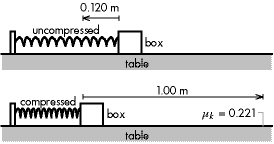Cuesta College, San Luis Obispo, CA
Physics 8A learning goal Q9.2
[20 points.] A 7.00 kg bowling ball of radius 0.150 m rolls up an inclined plane. When a Physics 8A student releases the bowling ball at the bottom of the inclined plane, it has an initial speed of 4.00 m/s. Assume that the bowling ball rolls up the inclined plane without slipping, and that work done by friction and air resistance against the bowling ball removes one-tenth of its initial energy by the time it reaches its maximum vertical height above the bottom of the inclined plane. Find the maximum vertical height increase of the bowling ball above the bottom of the inclined plane. Show your work and explain your reasoning.
(Cf. Young and Freeman, University Physics, 11/e, Problem 10.81.)
Solution and grading rubric:
- p = 20/20: Correct.
The intial total mechanical energy is K_rot + K_trans =78.4 J. One-tenth of this energy is lost to friction, so the open-energy
equation is
-(1/10)*(78.4 J) = (1/2)*(I_sphere)*(0 - w_i^2) + (1/2)*m*(0 -v_i^2) + m*g*(y_f - 0),
where w_i = v_i/r, thus y_f = 1.03 m. Or more simply, nine-tenths of 78.4 J is converted to U_grav, so m*g*y_f = (9/10)*(78.4 J). - r = 16/20:
Nearly correct, but includes minor math errors. - t = 12/20:
Nearly correct, but approach has conceptual errors, and/or major/compounded math errors. Omits K_rot (but still has frictional losses), or includes both K_trans and K_rot, but does not account for frictional losses. - v = 8/20:
Implementation of right ideas, but in an inconsistent, incomplete, or unorganized manner. At least attempts (open) energy conservation. - x = 4/20:
Implementation of ideas, but credit given for effort rather than merit. - y = 2/20:
Irrelevant discussion/effectively blank. - z = 0/20:
Blank.
Grading distribution:
p: 3 students
r: 3 students
t: 12 students
v: 12 students
x: 2 students
y: 0 students
z: 0 students










